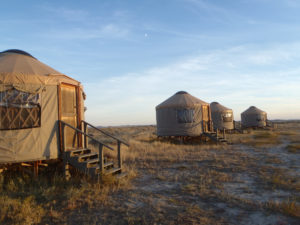 We were in the middle of nowhere. The flat plains stretched infinitely into the dimming horizon. We had no cell phone reception, no way to communicate with our friends or family, and no trees to retreat behind in moments of introspection. Though this harsh, windswept landscape seemed to hide nothing nor allow anything to hide, it is burdened with a long history that we’d learned about over the past few days during our time at the American Prairie Reserve.
We were in the middle of nowhere. The flat plains stretched infinitely into the dimming horizon. We had no cell phone reception, no way to communicate with our friends or family, and no trees to retreat behind in moments of introspection. Though this harsh, windswept landscape seemed to hide nothing nor allow anything to hide, it is burdened with a long history that we’d learned about over the past few days during our time at the American Prairie Reserve.
I reflected on this history and our learning as I gazed into the vast expanse. While we’d spent so much time on the Missouri River discussing humans’ destruction of the plains and the river through cattle grazing and inappropriate agricultural practices, our time at the American Prairie Reserve (APR) had shown me that humans can very effectively channel their efforts to restore the prairie to its natural state. We had the opportunity to witness this firsthand as we spoke with important leaders at the APR and helped them with a yurt-building project in return for their time and for allowing us to stay at their established yurt camp at the APR. We learned of how they are working to purchase and accumulate 3.5 million acres of land, including the BLM grazing leases attached to private properties, around the central APR area, north of the Missouri River Breaks and the Charles M. Russell Wildlife Refuge. This, in essence, is an effort to preserve one of the last remaining viable temperate grasslands—the least protected of any type of ecosystem—in the world. They mostly rely on wealthy individuals to donate large chunks of money to the cause, and it takes some convincing to persuade these people to donate money. Hence the yurt camp that we helped to build; here, the APR will host wealthy donors for overnight stays so they can experience the APR firsthand.
We found this to be an intriguing philosophy, and grappled with our inner conflicts regarding whether we can support an effort that mostly relies on wealthy donors giving money to a private organization. But as we stood overlooking a genetically pure, brucellosis-free herd of bison that the Reserve has restored to the landscape and watched their dark figures lumber away across the prairie single-file, looking so correct in that place, we were filled with gratitude that a small group of people has worked so hard to make this a reality. It didn’t matter where the money came from, because it was being channeled into a good cause.
mostly relies on wealthy donors giving money to a private organization. But as we stood overlooking a genetically pure, brucellosis-free herd of bison that the Reserve has restored to the landscape and watched their dark figures lumber away across the prairie single-file, looking so correct in that place, we were filled with gratitude that a small group of people has worked so hard to make this a reality. It didn’t matter where the money came from, because it was being channeled into a good cause.
And bison aren’t the only creatures being restored to the prairie. Yesterday afternoon, we’d spent three hours choosing and researching a species that we would each represent at the Council of All Beings, our exam for the second section of the course. Poring over books in the sunny yurt and scribbling madly, we each became familiar with the history of our creature on the plains or in the Breaks. We connected our learning with our knowledge on Native American history, white homesteaders’ influence, and changes in land use and policy over the last three hundred or so years. Many life forms have undergone significant changes during this time period, resulting in their partial or total disappearance from the prairie. After we’d finished our research, we presented our findings to one another at the Council of All Beings meeting in the candlelit yurt, dressed to resemble our being: Brooke as river algae, Lincoln as prong-horned antelope, Rosie as cottonwood tree, Robert as sage grass, Sam as bald eagle, Anna as beaver, and me as bison. I was enthusiastic that the APR was working to restore the natural state of each of these species in their efforts.
Alas, the many human actions that have influenced the land and disturbed its natural state are very obvious on the prairie; this land hides nothing and its history, though invisible in some ways, is reflected in every plant, every animal that is or isn’t there. The prairie’s transparency, but also its deep mystery, allows me to free my mind of the information clutter I continue to accumulate as the daylight wanes and the fall progresses. Here, I can just be present in the clear air, observing as the horizon drops into the abyss and the stars appear, unobscured and illuminating.